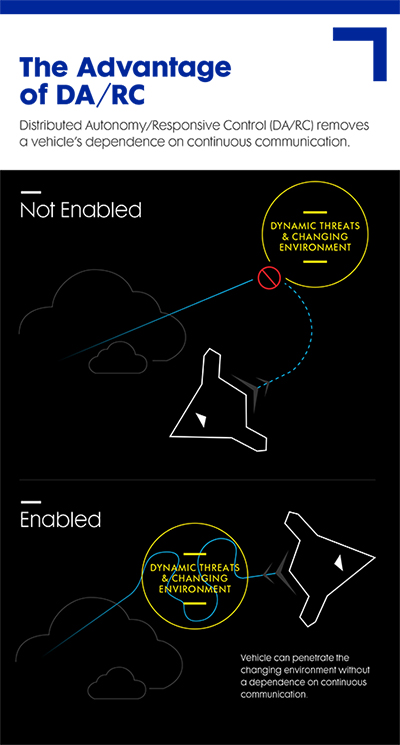Connected to Defend
Take a look at how Distributed Autonomy/Responsive Control (DA/RC) underpins a new approach to battle management

By Elizabeth McCann
Deep in the desert of a powerful foreign adversary, hemmed in by rugged mountains, sit three strategic military targets. They're heavily guarded, with fighter jets in the air and sensors to guide an integrated air defense on the ground. Off the coast, three bomber aircraft are poised to strike, but they need a clear path.

A fleet of allied fighters and remotely controlled autonomous aircraft soar in, leading the way ahead of the bombers. The autonomous aircraft are there to collect intelligence and jam signals, while the fighters provide cover. The bombers move ever closer to the shoreline. Invisible to radar through stealth technology, other planes in the sky can still visually spot the bombers, and while they carry heavy ordinance they can't engage in air to air combat. They're relying on their comrades to create an open path.
Thousands of miles away, in a room lined with computers and large glowing monitors, sits a cadre of pilots, sensor operators and intelligence officers. They're on the loop, meaning they can take control of the autonomous planes if need be. But for now, they supervise the progress. The autonomous systems carry out a pre-planned mission of surveillance and jamming. The fighter pilots keep the enemy at bay.
As the allies flood the airspace, moving closer to the targets, the enemy fighters close in to protect their assets. The allied autonomous systems are jamming enemy ground sensors, leaving the enemy fighters at a disadvantage. For the moment, there is still a mountain range between them and the allied forces moving toward them, and without ground intelligence, they're blinded from the action. Slowly but surely, on the other side of the mountains, the bombers are closing in.
Back on the ground, in that room thousands of miles away, the sensor operators work to sort through intelligence data. Software makes the task easier than it's ever been, processing more information quickly. Pilots keep an eye on the theatre. The same software system that helps sort intelligence can analyze flight paths and monitor vehicle status, leaving the pilots free to track mission objectives while managing multiple planes at once. As the pre-planned mission unfolds, the system adapts in real-time to new information and threats. The autonomous aircraft jam more and more sensors as the bombers move in, only 30 minutes from their targets.
As the allies come over the mountains, the enemy fighters can finally see what's coming. While they may lack ground intelligence, they still have their eyes and onboard sensors. They begin to fire. If any allied autonomous systems fall this is where the full advantage of the software system really comes through. The system is distributed in both the ground stations, and onboard individual vehicles. If damage occurs in battle, the other systems will adjust and continue the mission. Now, it is the allied fighters turn to engage.
All of their training has lead up to this. The advanced software system on board the fighter jets provides the pilots with better guidance than they've had before. In seconds, the system sorts through a vast array of data and tells them what's coming, in which formation, and the best engagement strategy. Vital decision aids perform in the blink of an eye. Using these advanced aids, a pilot pulls the trigger and sends a missile screaming through the sky.
It's a direct hit.
In the ground station thousands of miles away, officers watch as several enemy fighters blink out and disappear from their monitors. Relief washes over the servicemen and women sitting there, but there is no time to celebrate. The mission is still in motion. The autonomous systems fly over the targets, jamming any remaining signals. The fighters keep pace, ready to fend off any incoming enemy. With a clear path, the bombers move into position, and strike. The military targets are destroyed. Mission accomplished.
None of this actually happened. It was a simulated exercise, a demonstration of a sophisticated software system called DA/RC. But the scenario is completely possible. DA/RC stands for Distributed Autonomy/Responsive Control. It distributes autonomy across a network of vehicles and command centers. It better enables battlefield management between manned and unmanned systems, even in non-permissive environments. The scenario described here, with its mix of pre-planned missions, and real-time responses governed by rules of engagement, is just one sample of its power. DA/RC uses advanced algorithms to improve tactics and generate more useful solutions. It will underpin future systems that could change the nature of battle management.